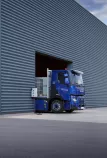Welcome to Renault Trucks Content Hub
List of content
What types of fuel sources to use for decarbonisation?
Electromobility
Green Energies
Mar. 7 2022

What types of energy are available today to power a truck?
There are 4:
- Diesel
- Gas
- Hydrogen
- Electricity
Let’s review them one by one to see which will be the most effective in reducing CO2 emissions.
Note that all the CO2 emission reduction figures quoted are calculated from cradle to grave, in other words, they take into account all the CO2 emitted, from the production of energy and vehicles to the end of the vehicles' life. These calculations were made for a 16-ton vehicle.
Diesel fuel
Bio-Diesel, a fatty-acid ester produced from vegetable oils such as rapeseed, provides a 65% savings on CO2 emissions compared to fossil-based diesel fuel and could be a good supplement for de-carbonising the road transport of goods. At present, it is obviously one of the cheapest solutions.
However, the use of bio-diesel for road transport is restricted by the limited quantities available, and its production can also engender risks of deforestation and encounter competition from other sectors, such as food production.
By 2040, it is very likely that no more than 10% of trucks will be using this type of fuel.
Synthetic fuels (XTL, HVO), second-generation biofuels, provide further reductions in CO2 emissions. Obtained from animal fats, used oils, or forestry residues, they do not compete with food products. However, the quantities currently available are very small and will probably remain so for the next few decades, since the amount of usable raw materials is limited.
E-diesel, produced using renewable electricity, water and CO2 from the atmosphere, also provides a 65% reduction in emissions compared to fossil diesel fuels. However, making it available requires massive investments that are still not a sure bet.
Gas
This means methane, which exists in two forms: fossil natural gas and biogas produced from the fermentation of gasification of organic matter (biomass).
Fossil natural gas provides a savings of only 5% of CO2 emissions compared to diesel fuel. It is thus not a viable option for de-carbonisation.
Bio-Methane or biogas, produced by the fermentation or gasification of organic matter, serves to emit 75% less CO2 than with diesel fuel. However, the quantities of biogas available are, and will remain, limited. Thus, for its use, the transport sector will be competing with other business sectors, and its price (4 times higher than natural gas in 2019) is due to rise due to the probable decrease in public funds for its production.
Biogas emits nitrogen oxides (NOx), which will disqualify it for use in the city. Lastly, its potential greenhouse gas effect, which contributes to global warming, is 86 times that of CO2 over an 80-year period and thus requires very close monitoring to minimize the risks of leaks during its production and transport.
About 10% of trucks, probably heavy, long-distance and construction vehicles, will likely run on biogas as of 2040.
Electric power
On average, in Europe, de-carbonised electric power produced from renewable energy sources or nuclear generation currently allows for a 55% savings in CO2 emissions compared to fossil-based diesel fuel. In some countries, such as France, that savings is over 80%.
The technology for electric motors is readily at hand, and the working charge of batteries is steadily increasing.
Free of direct emissions effects, electric trucks are the most efficient solution to urban pollution problems. They can be recharged at night - during off-peak hours - on either an industrial, three-phase connection or a basic charging terminal, they run silently, and they provide great comfort of use for drivers.
Although electric vehicles continue to be more expensive than those running on diesel fuel, the gap is continuously closing, and some applications, such as trash collection, are already fully competitive. Starting in 2025, the total cost of owning and operating a battery-powered electric truck for city use will be less than that of a diesel fuel truck. By that date, all types of urban uses will be covered by electric trucks.
Moving towards carbon neutrality
A “from the cradle to the grave” analysis of trucks, of their total cost of operation, of their ease of use, and of the availability of de-carbonised fuels, has led us to foresee the use of the four available fuel types by 2020 in the following proportions:
- 0% of trucks using fossil-based diesel fuel or natural gas.
- Up to 20% of trucks running on bio-fuels for the heaviest uses (long-haulers, heavy construction, etc.).
- Around 80% of trucks will be equipped with either recharged, electric batteries, of de-carbonised hydrogen fuel cell power for the most demanding uses. The exact proportion of use of these two power sources is still unknown.



